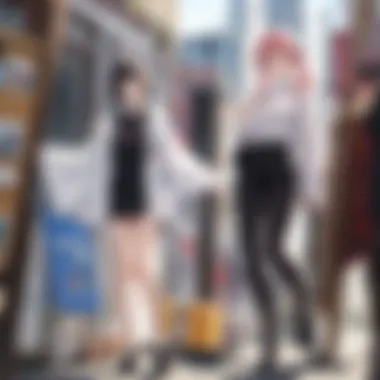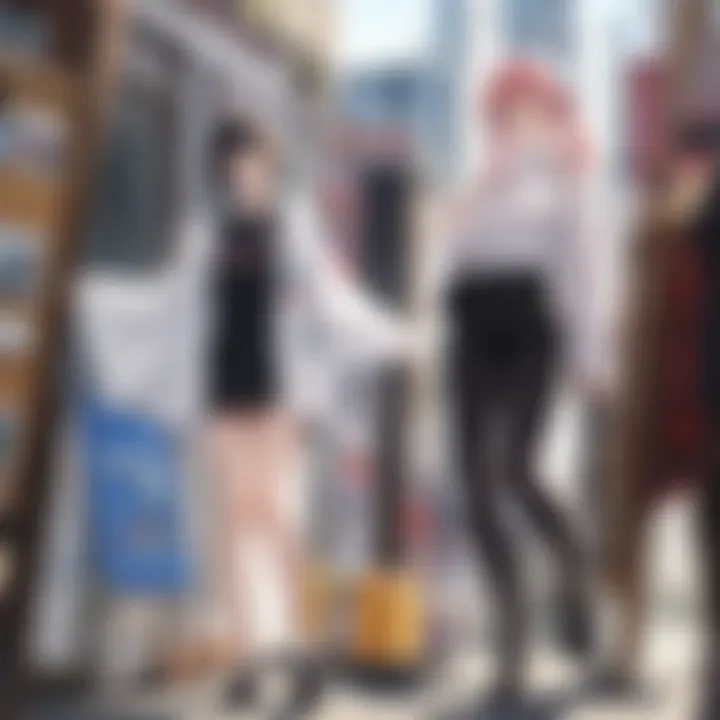Exploring the Most Acclaimed Manga Animes


Intro
Manga animes represent a significant cultural phenomenon that resonates globally. Their storytelling prowess and artistic advancements have continuously shaped and redefined narrative forms. The unique blend of vivid illustrations, compelling plots, and emotional depth draws audiences into diverse worlds. This article delves into essential aspects of manga animes, focusing on character profiles, thematic exploration, and noteworthy series. Through this exploration, readers will discover why certain titles elevate themselves above the rest in both impact and appreciation.
Character Profiles
Overview of Main Characters
Main characters in manga animes often serve as conduits for exploring intricate themes. They possess distinct personalities, ambitions, and conflicts that capture viewer interest. For instance, Goku from Dragon Ball exemplifies resilience and relentless determination, underscoring themes of friendship and fighting against adversities. Similarly, Naruto Uzumaki from Naruto brings forth the journey of self-discovery and the pursuit of dreams, engaging audiences through his growth and development.
Supporting Characters
Supporting characters play pivotal roles in enriching the narrative. They provide depth and contrast to main characters. Sasuke Uchiha, as Naruto's rival, portrays the struggles of ambition and betrayal. In Attack on Titan, Mikasa Ackerman adds a layer of complexity to the story, reflecting loyalty amidst chaos. These characters amplify the emotional weight and themes portrayed, enhancing the overall storytelling experience.
Theme Exploration
Central Themes
Manga animes often delve into profound themes such as identity, perseverance, and morality. The concept of heroism is explored through various lenses. For example, One Piece challenges the notion of freedom and dreams as the characters strive to achieve their goals against formidable opponents. In contrast, Death Note examines the moral dilemmas surrounding justice, raising questions about right and wrong.
Cultural References
Cultural references embedded in manga animes resonate powerfully with viewers. The integration of Japanese folklore, societal issues, and historical events creates an authentic backdrop. Titles like My Hero Academia reflect Japan's education system, while Your Name intricately portrays contemporary urban life and traditional values. These references contribute to a richer understanding of the characters and stories.
Popular Series and Recommendations
Top Anime Series of the Year
In recent years, several series have garnered significant acclaim. Titles like
- Demon Slayer: Kimetsu no Yaiba
- Jujutsu Kaisen
- Attack on Titan Final Season
Each of these series elevates storytelling through impressive animation and character development.
Hidden Gems in Manga
Alongside popular series, there exist lesser-known titles that deserve recognition. Works such as
- Vinland Saga
- Pandora Hearts
- Mushishi
These series offer unique narratives and artistic styles, appealing to those seeking a different perspective within the genre.
Through careful examination of character profiles, themes, and noteworthy series, this discourse uncovers the essence of manga animes. By enriching understanding of their cultural significance, readers enhance their appreciation of this multifaceted art form.
Prelims to Manga Animes
Manga animes represent a unique fusion of artwork and storytelling deeply embedded in global culture. Their importance is multifaceted, influencing not only the entertainment industry but also broader societal norms and values. Understanding manga animes is essential for anyone wanting to engage with this phenomenon, as they embody a rich narrative tradition and artistic expression that transcends cultural boundaries. This article seeks to unravel those layers, offering insights into what makes manga animes significant.
Defining Manga Animes
Manga animes refer to animated works that are adapted from manga—Japanese comic books or graphic novels. These adaptations often stay true to the source material, capturing its essence while also expanding on visual storytelling elements. Manga itself varies in genre and style, catering to diverse audiences. In essence, manga animes represent a dynamic form of storytelling, where characters come alive through animation, and narratives unfold in vibrant colors and sounds.
This form of media often has distinct characteristics: clear lines, expressive characters, and unique settings. Each element contributes to the storytelling process. An anime can have many episodes, sometimes lasting for years, allowing for detailed character arcs and plotlines. This adaptability makes it appealing for long-term engagement.
The Cultural Significance
The cultural significance of manga animes is profound. They serve as a mirror reflecting societal issues, traditions, and modern dilemmas faced by audiences worldwide. This genre often tackles themes like friendship, perseverance, and the struggle between good and evil, making them relatable across cultures.
Furthermore, manga animes have played a crucial role in promoting Japanese culture globally. With their unique art styles and narrative techniques, they provide an accessible entry point for many to explore Japanese traditions, values, and even language.
"Manga animes are not just entertainment; they are a conduit for cultural exchange and understanding."
In addition, their influence is visible in various aspects of pop culture, from fashion to video games. Scholars and critics often explore how these narratives relate to contemporary society, making them subject for analysis beyond their role as entertainment. Understanding manga animes thus involves recognizing their broader impact in influencing cultural dialogues and shaping modern entertainment.
The Evolution of the Genre
The evolution of manga animes is a crucial aspect of understanding their current standing in pop culture. This development is not just about changing styles or trends; it reflects deeper societal shifts and advancements in technology that have shaped narrative forms. By examining its historical context, one gains insight into how earlier works set the stage for contemporary series. This section aims to pull back the layers of the genre, illustrating this progression in both thematic depth and artistic expression.
Early Influences


Early influences on manga and anime encompass various cultural and historical factors. The genesis of manga can be traced back to the late Edo period in Japan. Important works, such as Hokusai Manga, played a role in establishing a visual language that would inform the later development of the genre. Additionally, Japan's post-war recovery period saw an explosion of creativity, notably with artists like Osamu Tezuka, often termed the "God of Manga." Tezuka's work, especially Astro Boy, not only influenced storytelling but also established methodologies for character design and pacing.
- Key Factors in Early Influence:
- Cultural Context: The need for escapism after World War II provided fertile ground for unique narratives.
- Adoption of Western Styles: Early manga began integrating Western comic styles, blending them with Japanese traditions.
- Theatrical Influences: Kabuki and Noh theater traditions contributed elements of drama and character archetyping.
This background laid a foundation for diverse genres, from horror to romance, allowing manga to evolve into a multifaceted art form that appealed to various demographics.
Modern Developments
Modern developments in manga anime reveal how the genre continues to adapt and change. With the rise of digital platforms, the accessibility of manga has surged. This is significant; it allows creators to reach a wider audience beyond the traditional print market. Series like One Piece and My Hero Academia reflect current trends that blend nostalgia with innovative storytelling.
The integration of advanced technology has led to captivating animation styles and complex visual narratives. The advent of streaming platforms further transforms consumption habits. Characters and stories engage audiences in ways previously thought impossible. Key components of this evolution include:
- Diverse Narratives: Modern manga explores a wider array of themes, addressing social issues like identity and mental health.
- Fast-Paced Publishing: Online platforms enable faster publication, which encourages a continuous narrative flow.
- Global Collaborations: Manga now garners interest from creators worldwide, culminating in various unique iterations and interpretations.
By understanding these modern developments, one can appreciate the resilience of manga anime as a form of expression that not only entertains but also comments on contemporary society.
The evolution of the genre thus illustrates a dynamic interplay of tradition and innovation, making manga anime a continually relevant medium.
Key Characteristics of Manga Animes
Manga animes exhibit several key characteristics that are vital to their appeal and significance in the realm of animated storytelling. Understanding these elements is crucial, as they contribute to the overall narrative experience and shape the viewer's connection to the content. This section explores the narrative style, artistic techniques, and character development that define manga animes, revealing why these features resonate with a global audience.
Narrative Style
The narrative style of manga animes sets them apart from many Western animations. Primarily, these stories often focus on intricate plots and character arcs that can develop over long periods. Unlike episodic Western formats, manga animes tend to create layered narratives, where themes intertwine and evolve naturally.
This style allows for a deeper exploration of complex emotional and philosophical issues, encouraging viewers to reflect on the story's implications. Moreover, the pacing of manga animes can vary significantly. Some may emphasize sudden climactic moments, while others opt for gradual reveals that build tension over time. This versatility in story-telling format offers viewers a unique experience in consuming animated content.
"Manga animes often explore nuanced themes that linger in the minds of viewers long after viewing."
Additionally, the use of flashbacks and non-linear storytelling is prevalent in many titles. This structure adds richness to the narrative, allowing audiences to see the background of characters and events, often uncovering motivations not initially apparent. The depth this lends to the story enhances emotional engagement, making an anime memorable and impactful.
Artistic Techniques
The artistic techniques employed in manga animes are another defining characteristic. The visual style often varies widely, from detailed backgrounds to simplistic character designs. This diversity captures both the essence of storytelling and the cultural influences inherent in the art.
Many manga animes employ expressive character designs to convey emotions effectively. The exaggeration of facial expressions—such as massive sweat drops to indicate stress or wide eyes for surprise—plays a significant role in how feelings are communicated. Besides, the use of vibrant colors and dynamic scene compositions draws viewers into the world. Some series, like Attack on Titan, use darker palettes to enhance the atmosphere, while others may stick to bright tones to maintain a lighter, more whimsical feel.
Another notable aspect is the manipulation of perspective and angles in scene composition. Dynamic camera angles can create a sense of motion or tension during action sequences, making fights feel more intense. This artistic dexterity is a hallmark of manga animes and reinforces their depth as a medium.
Character Development
Character development is a crucial aspect of manga animes. Characters are often multidimensional, with distinct personality traits, flaws, and strengths. Unlike many Western animations, where character evolution can be secondary to humor or action, manga animes prioritize character growth throughout the narrative.
Typically, viewers are introduced to complex backstories that underpin character motivations. This foundation allows for more substantial transformations, enabling viewers to witness characters overcoming challenges and evolving in credible ways. Naruto, for instance, portrays an initially naive character who evolves into a mature leader through trials and tribulations.
Furthermore, relationships between characters often drive the story forward. The dynamics between friends, rivals, and enemies create a rich tapestry of interactions that highlight personal conflicts. These complex relationships invite viewers to become emotionally invested in not just the outcomes but in each character's journey as well.
In summary, the key characteristics of manga animes—narrative style, artistic techniques, and character development—combine to create an engaging and nuanced viewing experience. By recognizing and appreciating these elements, viewers can gain deeper insights into the artistry that defines this beloved medium.
Influential Titles in Manga Anime
The realm of manga anime is vast and rich, showcasing an array of narratives, styles, and characters that have influenced both fans and creators alike. Understanding these influential titles provides deeper insights into the genre's growth and varying nuances. These works encapsulate a blend of creativity, cultural resonance, and storytelling innovation that transcends borders.
Classic Works
Classic works in the manga anime genre set the foundational stones for countless creators and series that followed. Titles such as Astro Boy by Osamu Tezuka and Akira by Katsuhiro Otomo have etched their place in history by introducing radical storytelling techniques and artistic styles. Dragon Ball by Akira Toriyama effectively established a blueprint for shonen anime, emphasizing adventure while developing rich character arcs.
These titles possess significant historical value, illustrating the evolution of narrative complexity and artistic flair. They have influenced generational perspectives on themes of heroism, friendship, and conflict. Moreover, classics often serve as gateways for newcomers to discover deeper layers of meaning within the genre.
Contemporary Hits
On the other hand, contemporary hits highlight the ongoing evolution of manga anime. Titles like My Hero Academia by Kohei Horikoshi and Attack on Titan by Hajime Isayama resonate with modern audiences due to their intricate world-building and compelling characters. Demon Slayer: Kimetsu no Yaiba has also gained unprecedented acclaim, blending exceptional animation quality with profound character journeys.


These contemporary works often tackle contemporary issues such as identity, societal expectations, and personal struggle, making them relatable to today’s viewers. They are pivotal in enhancing the global appeal of manga anime, fostering communities around shared experiences and discussions.
"The narrative depth in both classic and contemporary titles illustrates the genre’s ability to adapt and remain relevant to cultural contexts."
Moreover, social media platforms such as Reddit and Facebook have facilitated discussions and fan theories, further amplifying the impact of these influential titles.
In summary, understanding these influential titles provides a blueprint of the manga anime's significance. It showcases their ongoing contributions to not only the industry but also the cultural landscape worldwide.
Genre-Specific Recommendations
Understanding the various genres within manga animes is crucial for both new and experienced fans. Each genre offers unique themes, character arcs, and storytelling styles. This section will highlight significant recommendations across three well-known genres: Shonen, Shojo, and Seinen. By focusing on these genres, readers can better appreciate the range of narratives and stylings that manga animes provide. Moreover, these recommendations serve as a valuable starting point for exploring the genre and its nuances.
Shonen Recommendations
Shonen manga animes primarily target a young male audience, but their appeal often transcends age and gender boundaries. These stories typically feature action, adventure, and camaraderie.
Popular titles in this genre include:
- Naruto is a quintessential Shonen series that combines thrilling battles with deep personal narratives about friendship and ambition.
- One Piece showcases not just adventurous escapades but also themes of perseverance and dreams, making it a long-standing favorite.
- My Hero Academia captures the essence of heroism, showcasing a unique world filled with quirks, which adds complexity to character development and plot.
The connection that audiences form with the protagonists in Shonen works often leads to a sense of belonging and inspiration, which explains their popularity globally.
Shojo Recommendations
Shojo manga animes, primarily aimed at young female viewers, delve into romance, relationships, and emotional growth. The focus on character interplay and intimacy resonates well with viewers seeking deeper connections.
Notable titles include:
- Sailor Moon, a groundbreaking title that blends magical transformation with themes of friendship and love.
- Fruits Basket addresses complex emotional layers with its exploration of acceptance, healing, and family ties.
- Your Lie in April is essential for its portrayal of grief, music, and young love, artfully weaving together heartache and beauty.
The Shojo genre creates a space for emotional exploration and relatability, fostering connections that resonate on multiple levels.
Seinen Recommendations
Seinen manga animes are intended for adult audiences, characterized by mature themes, in-depth storytelling, and complex characters. This genre challenges viewers with thought-provoking narratives that often delve into societal issues, personal struggles, and darker elements.
Prominent titles include:
- Death Note, a psychological thriller that explores morality and justice through a deadly game of wits.
- Berserk offers brutal yet profound insights into human nature, ambition, and the dark side of existence.
- Attack on Titan combines action and philosophical questions about freedom, survival, and the human condition, making it a staple in modern anime culture.
Seinen titles provide depth and complexity, challenging audiences to engage with content on a more serious level, highlighting the multifaceted nature of human experience.
Critical Reception and Impact
The critical reception of manga anime signifies its stature and relevance within both the entertainment industry and broader cultural context. This section examines how critics and audiences perceive manga anime, contributing to its evolution and the shaping of its narrative and artistic expression. Awards and recognition are essential indicators of excellence, while the influence on pop culture showcases how these works permeate various aspects of society.
Awards and Recognition
Manga anime has received numerous accolades that highlight its artistic and storytelling achievements. Awards such as the Eisner Awards, Harvey Awards, and the Kodansha Manga Award have acknowledged the exceptional quality and innovation within this genre. These awards do not just serve as trophies; they validate the hard work of creators and provide them recognition on a global stage.
Furthermore, accolades often drive interest and visibility. When a title such as Attack on Titan wins significant awards, it garners attention from media, leading to increased readership and viewership. This cycle is vital for both established franchises and emerging titles, as it opens doors for creative teams to develop future projects.
Another noteworthy aspect is the role of fan votes and community awards. Platforms like Reddit often hold their own awards, where fans acknowledge their favorite manga animes. This grassroots recognition can sometimes unearth hidden gems that formal institutions might overlook.
List of Notable Awards:
- Eisner Awards
- Harvey Awards
- Kodansha Manga Award
- Japan Cartoonists Association Award
These examples reflect the esteem in which manga anime is held, showcasing both critical and popular support.
Influence on Pop Culture
The impact of manga anime on pop culture is profound and widespread. The genre has transcended its origins, influencing global fashion, language, and even norms. Naruto, for instance, has inspired a myriad of cosplay events worldwide, creating a community tied together by a shared love for the series.
Moreover, phrases and styles originating from manga have made their way into everyday conversation and trends. This phenomenon can be observed in youths adopting specific traits or dialogues from their favorite series. The pervasive nature of these influences emphasizes how integral manga anime has become to contemporary culture.


Additionally, various franchises have ventured beyond manga and anime into other mediums. For example, Dragon Ball Z has spawned a successful video game series, further solidifying its status in regional and global pop culture. These adaptations often bring along a new audience who may not initially engage with traditional manga.
Trends in Manga Animes
The landscape of manga animes is not static; it evolves consistently, reflecting changing societal values, technological improvements, and shifts in audience preferences. Understanding these trends is crucial for readers and creators alike, as they not only reveal what resonates with viewers but also provide insight into the future of the genre. This section will discuss the key trends currently influencing manga animes, focusing on shifts in themes and technological advances.
Shifts in Themes
Over the past decade, there has been a noticeable shift in themes within manga animes. Traditionally, many narratives centered around heroism, adventure, and straightforward conflict. However, newer works delve into more complex and varied themes. Stories often explore mental health, existentialism, and social justice. This evolution allows for richer character development and more relatable narratives.
Manga such as Boku Dake ga Inai Machi (Erased) illustrate this shift with plots that revolve around trauma, loss, and redemption. Similar themes are found in Yasuke, where historical contexts meet the internal struggles of identity. These thematic changes not only reflect real-world issues but also engage a broader audience by encouraging deeper emotional connections with characters.
- Key thematic shifts can be outlined as follows:
- Increased focus on psychological depth.
- Exploration of societal issues like inequality.
- More diverse character representation.
This rise in complex themes fosters a more dynamic discourse within fandoms, pushing audiences to think critically about storylines and their implications.
Technological Advances
The impact of technology on manga animes cannot be overstated. Innovations in animation, distribution, and viewer engagement have fundamentally transformed the medium. Streaming platforms, such as Crunchyroll and Funimation, allow for immediate access to a wide range of series, fostering global appreciation and consumption of the art form.
Advancements in animation tools have also led to more visually compelling productions. For instance, series like Demon Slayer utilize advanced CGI techniques to enhance traditional hand-drawn animations, creating stunning fight sequences that captivate audiences.
- Technological contributions to anime include:
- Improved animation quality through CGI.
- Greater accessibility due to streaming services.
- Higher audience engagement through social media.
This technological transformation plays a vital role in how stories are told and experienced, emphasizing not just aesthetic quality but also accessibility.
Globalization of Manga Animes
The globalization of manga animes represents a significant transformation in how these unique forms of storytelling reach audiences worldwide. With the rise of digital platforms and the expansion of international markets, manga animes are no longer confined to their countries of origin. Instead, they increasingly cross cultural boundaries, influencing and adapting to various audiences around the globe. This expansion not only broadens the consumer base but also enriches the content by integrating diverse perspectives and storytelling techniques.
One of the primary elements driving globalization is the advent of streaming services. Platforms like Crunchyroll and Netflix have made it easier for viewers throughout the world to access both classic and contemporary titles. This accessibility has introduced numerous people to the art of manga animes who may have otherwise never encountered these works. The ease of access caters to varying tastes and preferences, opening up cultural dialogues that were once limited to niche circles.
Furthermore, this globalization enables the exchange of ideas and trends. Traditional Japanese narratives can adapt and merge with storytelling elements from other cultures, resulting in innovative works. This fusion creates a rich tapestry of content that resonates with broader audiences.
It's also important to consider how this transformation impacts the creators themselves. When artists and writers know their work will be shared internationally, they often shift their perspectives and styles. Consequently, they may incorporate global themes or cultural elements that reflect a more universally relatable experience.
International Adaptations
International adaptations of manga animes are sprouting in different forms, allowing local cultures to reinterpret these stories. For example, franchises like Death Note have seen live-action films and series produced outside Japan, including American adaptations. These adaptations introduce the narrative to new audiences but also provoke discussions about fidelity to the source material.
Adaptations can vary significantly. Some stay true to the original plot and characters, while others take creative liberties to suit local tastes. Additionally, adaptations frequently reflect cultural values and social norms of the target audience, which can lead to starkly different portrayals of themes and characters.
These changes can offer fresh insights yet also raise questions about the integrity of the original work. Debates around which adaptations merit attention or criticism continue to thrive in fan communities. As audiences engage with these discussions, strength of community builds around various interpretations, further enriching the manga anime landscape.
Crossover Appeal
Crossover appeal refers to the ability of manga animes to transcend their traditional fan base, drawing in viewers from various backgrounds and interests. Successful works often demonstrate a blend of genres, themes, or elements that intersect with popular culture trends. Titles like Attack on Titan and Naruto exemplify this quality; they integrate universal themes of friendship, conflict, and struggle, all while showcasing distinct cultural aspects of Japanese storytelling.
The appeal becomes even more pronounced when manga animes intersect with other media forms. Collaborations between manga artists and Western comic creators create new pathways for expression. Events such as comic conventions often bring together fans of different mediums, promoting cross-pollination of ideas and styles. Fans of video games, for instance, may find themselves drawn to the narratives of anime series that resonate with their gaming experiences, showcasing a new demographic eager for manga animes.
"The crossover appeal is where the magic happens—it opens doors for new audiences and fresh perspectives."
In summary, the globalization of manga animes enhances their reach and relevance, creating a dynamic world where cultures blend and narratives evolve. These processes not only benefit creators and consumers but also redefine the landscape of storytelling. As the genre continues to integrate and adapt, its future remains bright, promising an exciting journey for manga anime enthusiasts.
Finale
In summing up the discussion around manga animes, it's clear that they represent a unique blend of art and storytelling. Understanding manga animes allows the reader to appreciate their cultural significance and intricate narratives. The journey through the genre reveals how deeply rooted manga is in Japanese culture and how it resonates globally.
Manga animes are not just entertainment; they offer a window into different philosophies and social issues. They can challenge perceptions and provoke thought, which is one of their strongest traits. Readers who engage with this medium often find themselves immersed in vibrant worlds that pull them into complex emotional landscapes.
Final Thoughts on Manga Animes
Engaging with manga animes opens doors to countless narratives that explore various aspects of human experience. Their diverse genres appeal to a wide audience, reflecting personal struggles, growth, and the nature of relationships. Unlike many other visual storytelling mediums, manga animes often prioritize character development and intricate story arcs, which contribute to their lasting impact.
Moreover, we must recognize the influence of technology and globalization on the evolution of manga animes. As they expand into international markets, their ability to connect with diverse audiences enhances their relevance and reach. Thus, as fans of these series, it is essential to finish by encouraging each other to explore, support, and appreciate these works, fostering a community that values their artistic and cultural contributions.
"Manga and anime are not just forms of entertainment; they are also artistic expressions that reflect and shape culture."







